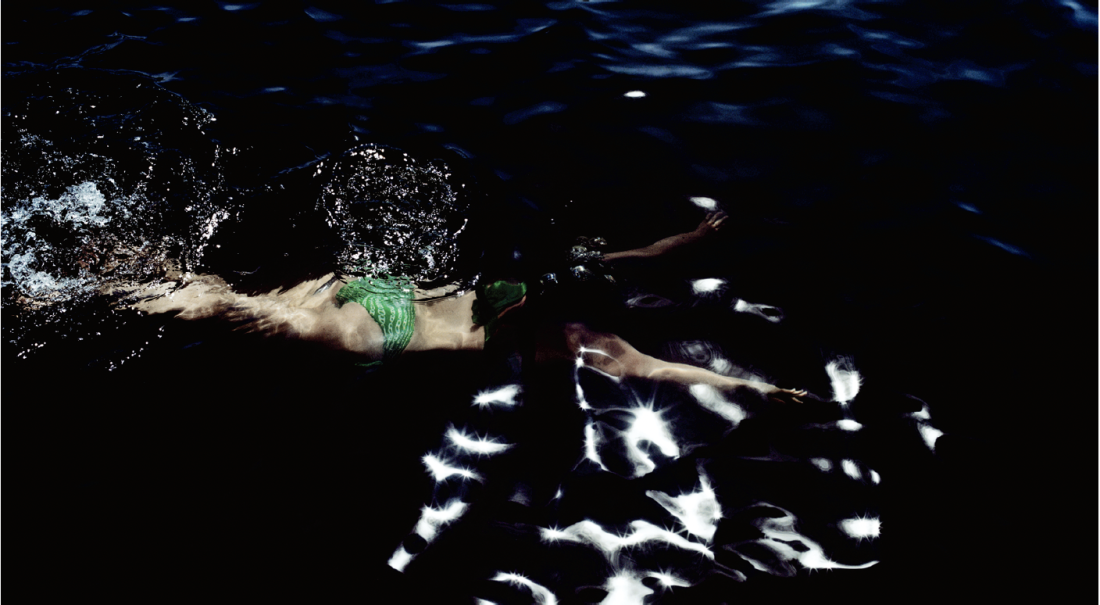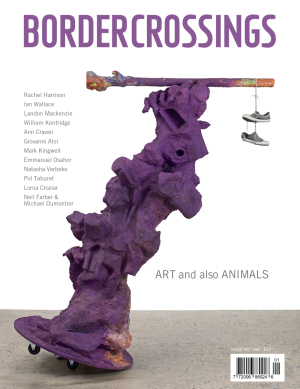d bradley muir
As part of Alberta’s Exposure Photography Festival, d bradley muir’s work occupies one of the two upper galleries in the Nanaimo Art Gallery. Curated by Nicole Stanbridge, it juxtaposes two bodies of work that at first appear to be quite different: the “dream home” and “swimmers” series. It’s worth noting by way of introduction that muir came to photography after seeing Jeff Wall’s A Sudden Gust of Wind (after Hokusai), 1993, a cinematic confection in which a rural cranberry field near Vancouver is also the restaging of a scene from a 19th-century Japanese woodcut. In Wall’s intensely digitized tableau, the stylization—unifying document and deference—moves lucidly towards the decorative. Though muir’s images are not digitally manipulated, like A Sudden Gust of Wind (after Hokusai), they contrast the reconstituted and the organic in such a way that attention to nature as mise-en-scène gives way to a layered experience in which the artificial becomes the more tangible and durable referent.
The “dream home” pieces, in muir’s words, lie “in the interstice between tableau and documentary photography.” He builds stage-set-like “flats” made to resemble the walls of domestic interiors and positions them in natural settings. This setting is transformed into a “view” by an unglazed window in the wall (invariably, the view framed by the “window” is both a recognizable part of the landscape and a discreet scene in its own right.) Also on the wall, a fine art reproduction in the form of a “ready to hang” print offers an alternate vision of framed landscape. The interior has the crisp, contained look of a condo show home, and the colour used to paint the wall (as in Behr’s ColorSmart System’s Ocean Kiss) furnishes a work’s title: a readymade romance linking wall and wilderness.
Accessories complete the scene: potted plants, a laundry bin and a taxidermy rooster in Homer House (half of a two-part homage to Homer Watson.) Some, like a distended vacuum cleaner in Impressionist Open Valley, drift desultorily out of bounds, linking the “interior” and the world at large in a way that suggests occupant and event. Artist as interloper is a role that interests muir, who in a “covert performance” purchases his objects on the day of the shoot, returning them for a refund later. Building, positioning, dressing and photographing the set become a cycle of making, consuming, recording and undoing that accompanies the shift from false aspiration to true presentation. An outcome of this cycle is an implicit, invented identity.

d bradley muir, Untitled (Kristen), 2010, Lightjet C-Print, 51 x 81 cm. Courtesy the artist.
Perhaps this is why one of muir’s subtopics in “dream home” is the artist at work in nature (along with the Watson pieces, he has made Hilltop: Odds and Ends for Emily Carr). Artist and landscape participate in a porous affiliation in which each is subjected to a mythologizing process in reference to the other. muir also relates this exchange to what he describes as the “pre-emptive nostalgia” of outdoor leisure activities in the “swimmers” series.
“Swimmers” captures bodies in dark water. Each is a faceless portrait, incorporating the name of its subject and, more tellingly, the particular stroke that defines that individual’s way of carrying themselves. But each swimmer is also oblivious, lost in concentration, and a suspension that the picture crops and belies. The sheen of the images is the liberation and interference of light in the aperture, both projecting and interrupting a voyeuristic longing.
While muir claims his approach to this more lyrical body of work was “not overly technical,” the pictures feel didactic, if not without affinity. They were modelled after images taken by his wife’s grandfather, an artist working in Ontario in the 1950s, as source material for painting. Like Thomas Eakins’s curiously urgent photographic studies of students at a swimming hole, the “swimmers” evince that quality of lack (readable as eroticism) that images meant for other images have. muir admits to finding some of the images sinister, the black water at times isolating in ways that recall the threatening tug of murky weeds or a breath pushed out by sudden chill.
Maybe exemplary is the word that connects the tableaux of “dream homes” to the studies that are the “swimmers.” Bubbles eddying around bodies could recall Chardin, whose bubble-blowing innocents have the cautionary probity of still-life subjects. Where the flats are baffles of articulation, dependent in familiar ways on our foreknowledge of the game of place making, the swimmers are opaquely liminal. The moment of framing is still what matters, but we become aware (in a way that Stanbridge says “activates” the flats from a fresh perspective) that the choosing is predicated on alternating motives of desire and determent. Their juxtaposition suggests the dissolution between public and private pictures that for all its nostalgia is very timely. ❚
“Dream Home,” curated by Nicole Stanbridge, was exhibited at the Nanaimo Art Gallery in Nanaimo, BC, from May 14 to July 17, 2010.
John Luna is a painter, critic and teacher who lives in Victoria, BC.

